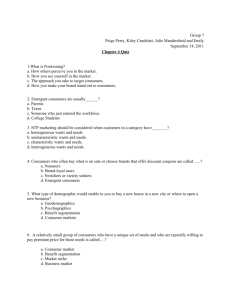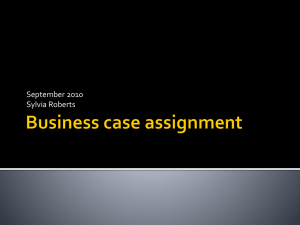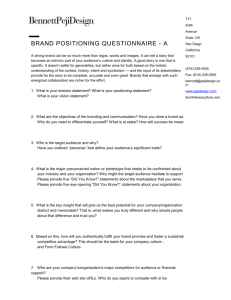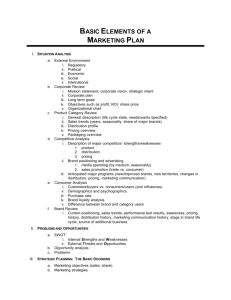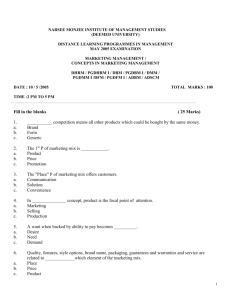positioning statement
advertisement
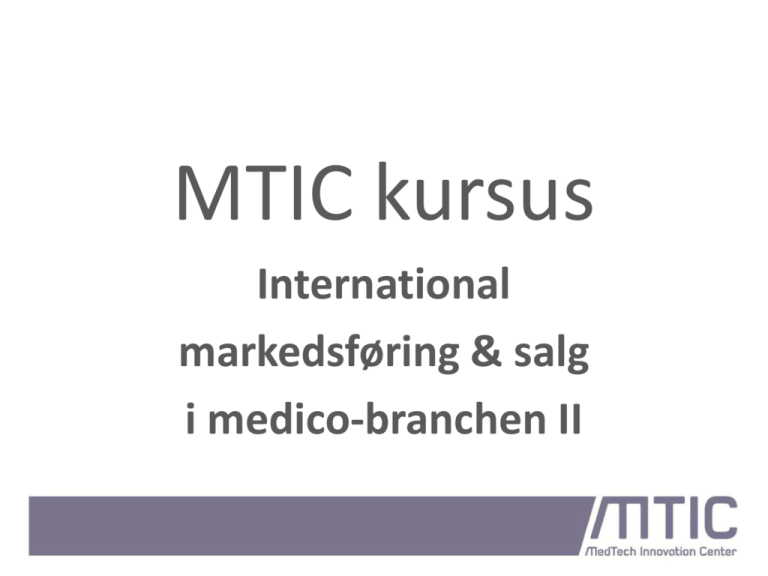
MTIC kursus International markedsføring & salg i medico-branchen II Program – del 2 Segmentering og positionering 13.00 Velkommen og introduktion til dagens program. Opsamling fra sidste work shop 13.30 Segmentering og målgruppevalg: hvem er mine kunder og hvordan segmenterer jeg dem? 14.00 Positionering: Hvordan definerer jeg mit produkt, og hvad er det sammenlignet med konkurrerende produkter? 14.30 Pause 14.45 Segmentering, målgruppevalg og positionering for jeres virksomhed. Lav et positioning statement og diskuter det med naboen 15.30 Tilbagemelding fra grupperne og diskussion 16.00 På gensyn Stakeholder Map Flow of Money / Cycle of Care Governmt. Officials/ Patients Legislators Patients Advocacy Groups Public Payers Physicians Medical Need Private Payers Facility Trade Groups Prof. Association Nurse Practitioners Health Care Facility MedTech Staff Two important messages • Map your stakeholders • YCDBSOYA HotWatch A Practical Approach to Stakeholder Analysis “Take chances, make mistakes, get messy!” Ms. Frizzle, The Magic School Bus HotWatch HotWatch HotWatch • Global Business Engineering project at VIA University College – Make a market analysis for: D, I and UK – Select the most attractive market and develop a marketing plan HotWatch • Small scale local analysis at Responce – Map stakeholders – Obtain domain knowledge – Listen and learn HotWatch Outcome • Complete stakeholder map – Responce – Region Midt – KOL • • • • • European standard for ambulance equipment Competetive and substituting products Innovative business partner (Fremskudt HospitalsEnhed) Ideas for further product development Contacts to largest private German ambulance service provider, GARD19221 Core Competency Core competency • Competitive advantage derives from deeply rooted abilities which lie behind the products that a firm produces • They allow the firm to diversify into new markets by re-applying and re-configuring what it does best Prahalad, C. K. and Hamel, G. ”The Core Competence fo the Corporation,” Harvard Business Review, 68, 3, May-June 1990: 79-91 Market segmentation Market segmentation Market segmentation involves dividing large, heterogeneous markets into smaller segments that can be reached more efficiently and effectively with products and services that match their unique needs A market segment A market segment consists of a group of customers who share a similar set of needs ad wants A market segments must • Be profitable • Be accessible • Match the company (brand, positioning) Segmenting consumer markets Geographic Demographic Psychographic Behavioural Segmenting business markets Geographic Demographic Type of firm Attitudes Market targeting Market targeting involves evaluating the various segments identified during the segmentation process and deciding how many and which segments it can serve best Segmentation and targeting Market Segment A Segment B Segment C Målgruppe Målgruppe Patterns of target market selection P = product / M = market 5 MINUTTERS PAUSE Slogan/Pay off/Motto • BMW: The Ultimate Driving Experience • Audi: Keeping ahead through technology • Mercedes: The best or nothing Positioning To succeed in our overcommunicated society, a company must create a position in the prospect’s mind a position that takes into consideration not only a company’s own strengths and weaknesses, but those of its competitors as well Positioning terminology • USP – Unique Selling Points USP – Points of Parity POP – Points of Difference POD Value proposition • Value proposition Positioning statement – Sum of total benefits that a company promises to a customer in exchange for payment (or other value) • Positioning statement – Summarizes a brand or a company’s positioning Positioning terminology, cont. • • • • • • • brand strategy positioning strategy brand positioning Slogan Pay off Motto (Mission statement) Unique Selling Points Points-of-parity (POPs) • Defines category membership • Associations that are not necessarily unique to the brand but may be shared with other brands Points-of-difference (PODs) • Attributes or benefits consumers strongly associate with a brand, positively evaluate and believe they could not find to the same extent with a competitive brand General value propositions Price Medical Value propositions Value Proposition Stakeholder net effect + Stakeholder net effect - Examples Decreased procedure invasiveness Facility Patient Payer Laparoscopic (minimally invasive) procedures versus open surgery Reduced need for future treatment (e.g. monitoring or complications) Payer Patient Facility Physician Drug eluting stents (reduce need for treatment of restenosis) Increased need for future treatment or diagnostics Facility Physician Patient Increased opportunity for bundling procedures Facility Physician Mammography screening to find malignancies early to receive timely treatment Payer 3D mapping and ablation for AF (2 seperate prodecural steps reuqired to be done in same procedure) Elements of a positioning statement • Target Audience – The attitudinal and demographic description of the core prospect to whom the brand is intended to appeal; the group of customers that most closely represents the brand’s most fervent users • Frame of Reference (POP) – The category in which the brand competes; the context that gives the brand relevance to the customer • Benefit (POD) – The most compelling and motivating benefit that the brand can own in the hearts and minds of its target audience relative to the competition • Reason to Believe – The most convincing proof that the brand delivers what it promises Criteria for Evaluating a Positioning Statement • Is it memorable, motivating and focused to the core prospect? • Does it provide a clear, distinctive and meaningful picture of the brand that differentiates it from the competition? • Can the brand own it? • Is it credible and believable? • Does it enable growth? • Does it serve as a filter for brand decision making? www.brandeo.com Positioning statement A positioning statement is a statement that summarizes company or brand positioning For (target audience), (brand name) is the (frame of reference) that delivers (benefit/point of difference) because only (brand name) is (reason to believe) Mountain Dew’s positioning statement To young, active soft-drink consumers who have little time to sleep, Mountain Dew is the soft drink that gives you more energy than any other brand because it has the highest level of caffeine Positioning map Price High Low High Low Quality Positioning map Target group Mature Classic Trendy Young Lifestyle Differentiation strategies Product Personnel Channel Image Product differentiation • • • • • • • Product form Features Performance Conformance Durability Reliability Reparability • • • • • • • • Style Design Ordering ease Delivery Installation Customer training Customer consulting Maintenance Formulate a positioning statement for your company • Target Audience – The attitudinal and demographic description of the core prospect to whom the brand is intended to appeal; the group of customers that most closely represents the brand’s most fervent users • Frame of Reference (POP) – The category in which the brand competes; the context that gives the brand relevance to the customer • Benefit (POD) – The most compelling and motivating benefit that the brand can own in the hearts and minds of its target audience relative to the competition • Reason to Believe – The most convincing proof that the brand delivers what it promises The digital immigrants must learn the language of the new world …from the digital natives Social media revolution
